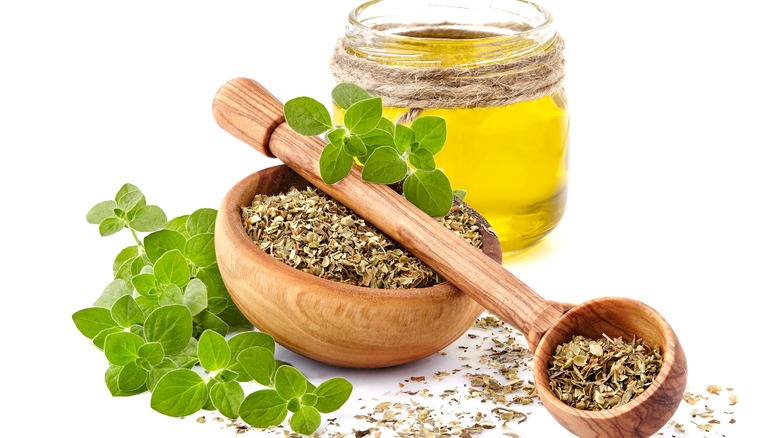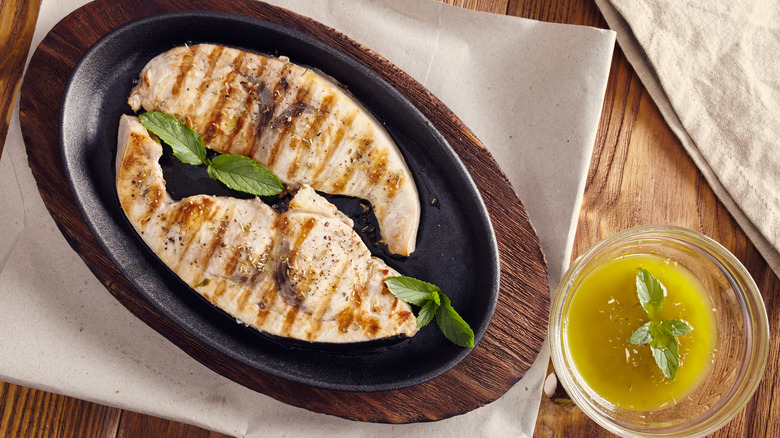What Is Salmoriglio And How Is It Used?
If you've never heard of salmoriglio, don't fret. You are far from alone. While this ancient dish has been around for years, very few foodies outside of the Mediterranean region have heard of it. One thing, however, is certain — once you familiarize yourself with this easy-to-prepare and relatively inexpensive Italian sauce steeped in tradition, it may become one of your most beloved go-to recipes.
So, what is salmoriglio? Used as both a dressing and a marinade, this Sicilian condiment consists of lemon juice, olive oil, garlic, oregano, water, and salt. Called sammurigghiu in Sicilian dialect, it is the perfect flavoring for a number of dishes — such as lamb, beef, and roasted vegetables — making this dressing incredibly versatile. It is, however, best paired with seafood; think swordfish, salmon, or shrimp. And, remember, if you wish to eat like a true Italian, always pair your favorite salmoriglio dish with great company and a generous helping of freshly baked bread.
What does salmoriglio taste like?
According to Eataly, the name salmoriglio translates to "little brine," hinting right away that the sauce possesses a certain degree of saltiness. However, while salt is present in the recipe, it's far from the star flavor in the sauce. Citrus notes from the lemon, pungency from the garlic, and freshness from herbs make this sauce very bright. As they do in much of their cooking, Italians prefer to "use a 'less is more' approach" when serving this sauce with fish, in order to let the seafood be the star of the dish.
While the traditional recipe of olive oil, lemon juice, garlic, oregano, water, and salt remains the standard in much of southern Italy, the sauce can vary slightly from town to town, per Italian blogger Philosokitchen. In the region of Calabria, it is called salamarigghiu in the local dialect, and fresh parsley is added to the concoction. In parts of Sicily, you can find a red version that has the addition of tomatoes, as well as one that uses white wine instead of lemon juice. Others may prefer to add other twists, including canned anchovies, capers, chili flakes (like Lidia Bastianich), and other fresh herbs like mint. And Greece has lemonolado, a dressing that shares all of the traditional salmoriglio's ingredients except garlic. Yes, it seems that there is a salmoriglio to suit every taste.
How to prepare salmoriglio
If salmoriglio sounds like taste perfection and you'd love to whip up some of your own, it's super easy. All you need are the aforementioned six ingredients and a bit of elbow grease to recreate this old-as-time recipe. It's best to use fresh ingredients, so you'll want to squeeze your own lemon juice and use high-quality oregano for the best taste. The real trick is to combine the garlic and oregano into a smooth paste; Eataly suggests finely chopping the ingredients, while Philosokitchen is team mortar and pestle. Rachel Roddy of The Guardian recommends one part lemon juice for every two parts of olive oil, along with just a clove or two of garlic and lots of good dried oregano. Next, you'll need to give all the ingredients a good whisk until everything is emulsified.
The tricky part will be deciding what you want to put it on first. To use it as a marinade, simply coat your protein or vegetable with salmoriglio before cooking it on the grill, in a pan, or in the oven. Otherwise, serve it on top of anything your heart desires (Roddy says hot dishes are best to bring out the flavors) and refrigerate any leftovers for up to a week. With so many recipes to choose from for chicken, lamb, scallops, haddock, and even eggplant, this condiment's versatility can cause even the most decisive brain to burst, but once you've crammed those dendrites back in place, you are in for an epicurean delight that will have your taste buds cheering.


